The following is a list of types of DDR cabinets and PCBs. It’s probably not exhaustive but it should cover the majority of hardware you’ll find in the wild.
Table of Contents
Cabinets
Generation 1
Generation 1 cabinets can be identified by their 29” CRT display and marquee that sits atop the base with two legs. While different variants came with 1st through SuperNOVA 2, upgrade kits to newer mixes are available. These cabinets use the JAMMA wiring standard for input/output.
Black cabinets
Black cabinets are the most common types outside of Japan and big chain arcades. They have black sides.
J-cabs

Japanese cabinets, or J-cabs for short, were generally built for Japanese use. They shipped with 1st through Extreme. They are usually identified by having a glossy black shell, a single coin slot, two separate pieces of metal comprising the panel underneath the screen (with PSX memory card readers in some cases), and the lack of a black bezel around the subwoofer area. There are bolt heads on the sides of the monitor housing to support its brackets. The amp/PCB units are placed side-by-side in the cabinet. If there is a blue “GET ON THE DANCE STAGE !!” sticker beneath the select/start buttons, it’s a Dancing Stage True Kiss Destination J-cab.

US cabs
A variant of J-cabs, US cabs were distributed in America without memory card readers. They shipped with the US release of DDR 1st.
EU cabs
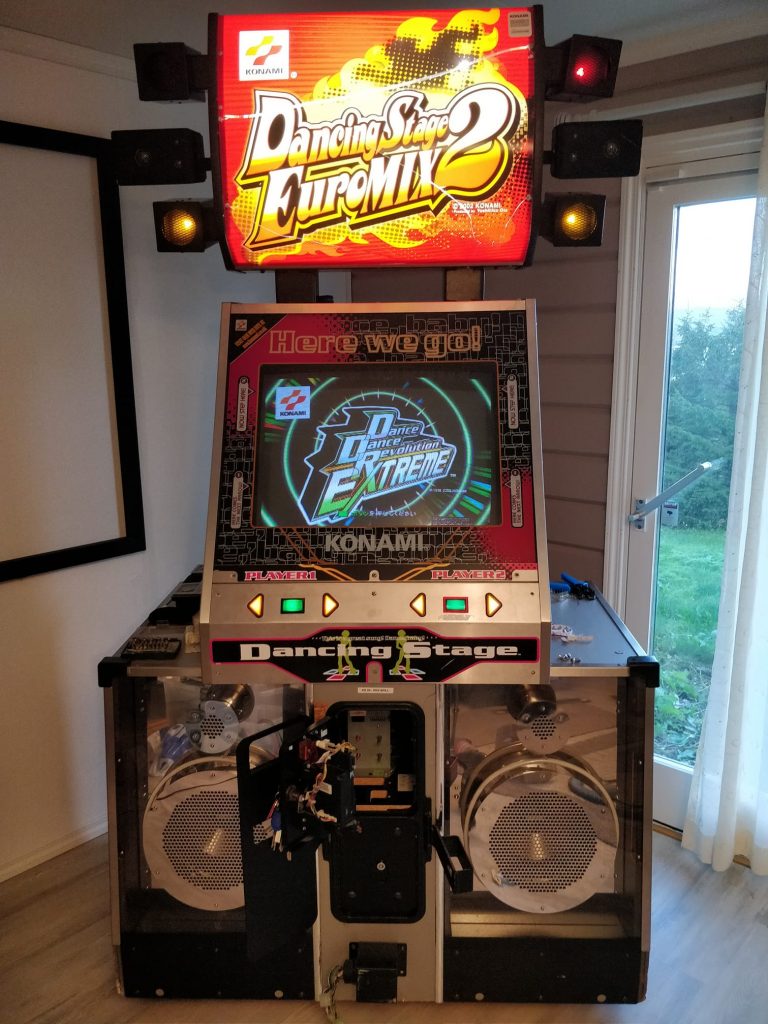
Although similar in appearance to J-cabs, these cabs generally have different parts. Screws, wiring, neons, speakers, shell are either incompatible, made with higher quality material, or both. The component pieces (subs, PCB/amp/PSU enclosures, CRT, marquee) are separated with only small cable holes between them. Neons don’t have an L-shape at the bottom and go straight inward. Marquee spotlight acrylics are orange and red instead of pink and green. They have a 220v to 110v step-down transformer. There are multiple versions of these cabinets – black models shipped with versions of Dancing Stage 1st through EuroMIX 2, and gray models shipped with Fusion or SuperNOVA, but there are likely further differences between mixes.
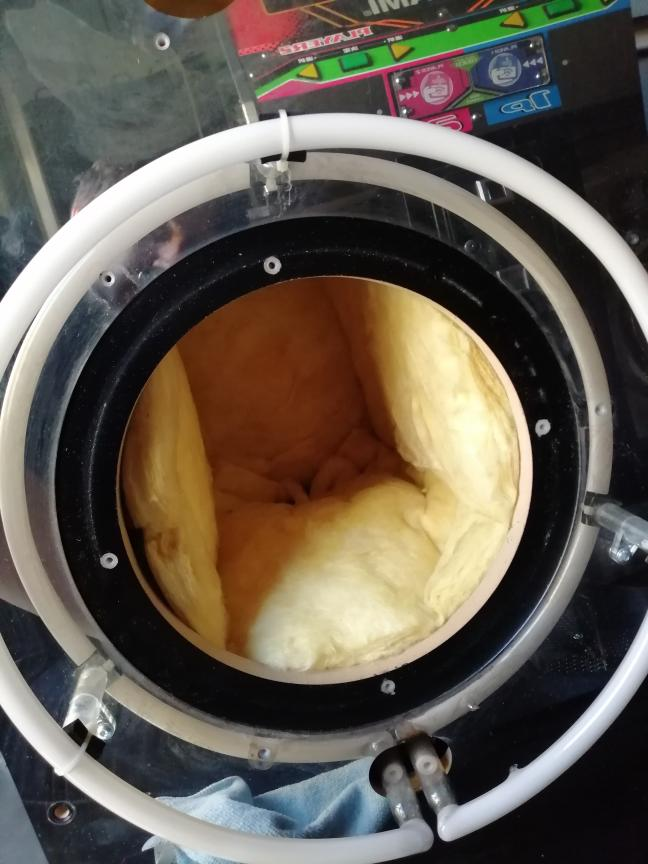
K-cabs
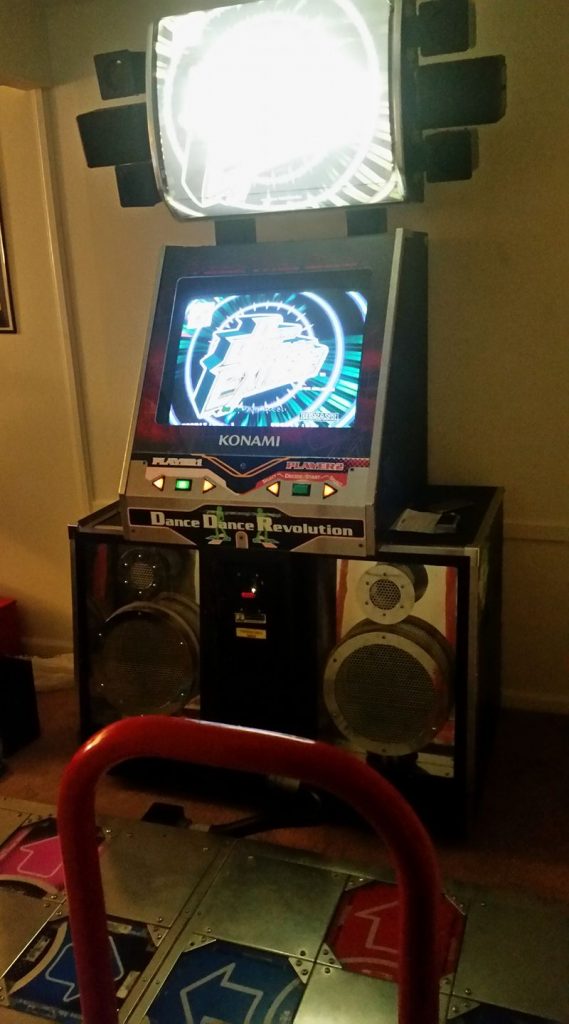
Korean cabinets are likely the most ubiquitous subtypes that you will find. They originally shipped with 3rdMix, but were changed to DDR USA when shipped overseas. They generally have two coin slots, a button panel underneath the monitor made of a single piece of metal, and a black bezel completely surrounding the subwoofer area. They are considered to be inferior to J-cabs due to the cabinet being built from MDF instead of plywood, its wires lacking proper grounding, and the monitor being secured via wood blocks instead of metal brackets. Other than wiring differences, the pads themselves are generally identical to J-cabs. The amp/PCB units are stacked from top to bottom in the cabinet.

Less common types
- Asian cabs – like K-cabs but the amp/PCB units are placed side-by-side like J-cabs.

- Namco “crapocab” – has square lights and different speakers on the sides of the marquee. Monitor bezel says “here we come” instead of “here we go!” Pads are made of plywood and covered in sheet metal. Usually runs a home version on a PSX or PS2. A big scam. Avoid!
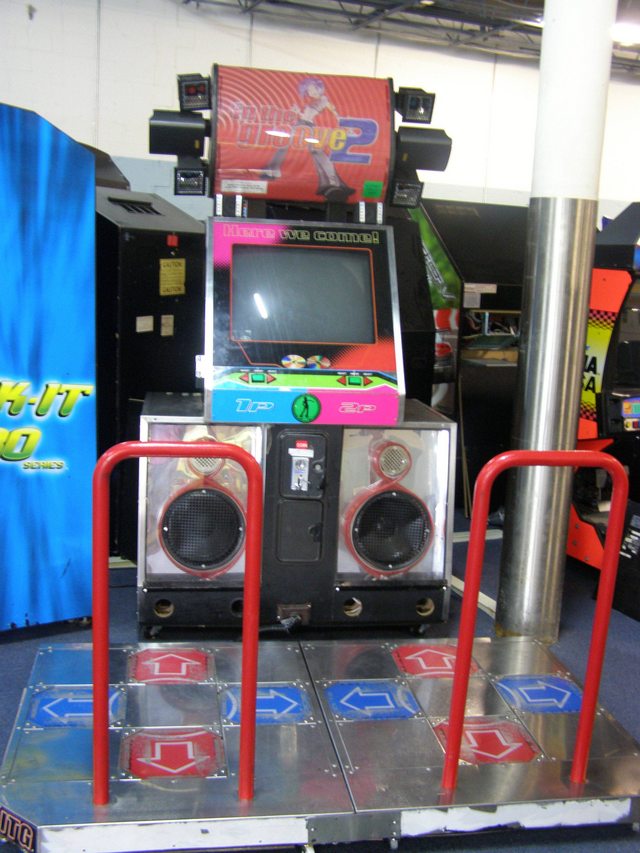
Betson cabinets
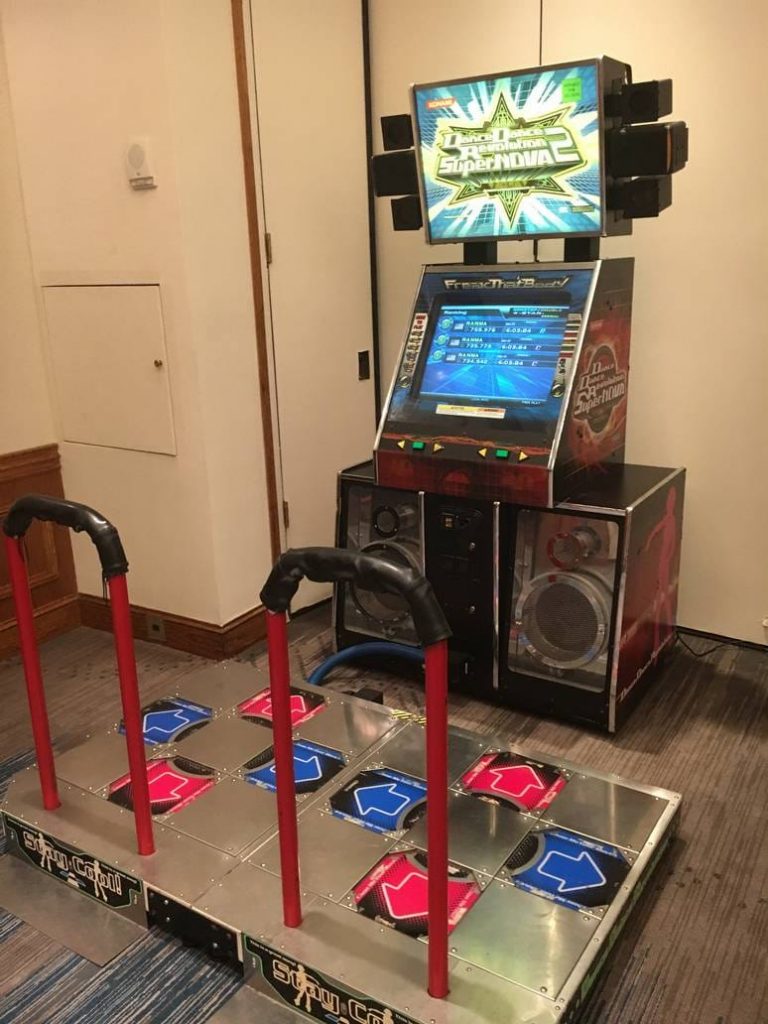
A newer type of US-built cabinet, Betson cabinets are similar to K-cabs in many ways, but can be identified by the front of the marquee being flat instead of curved. The cabinets themselves also have slightly less depth. They were distributed by Betson in America with SuperNOVA or SuperNOVA 2. Generally have better wiring – certain connectors were changed or removed for the purpose of easier servicing. Also have a better screen (Kortek multi-sync) than K-cabs. Both Betson and red cabinets use an EXT-IO board instead of the game PCB to handle panel/neon lighting.
Red cabinets
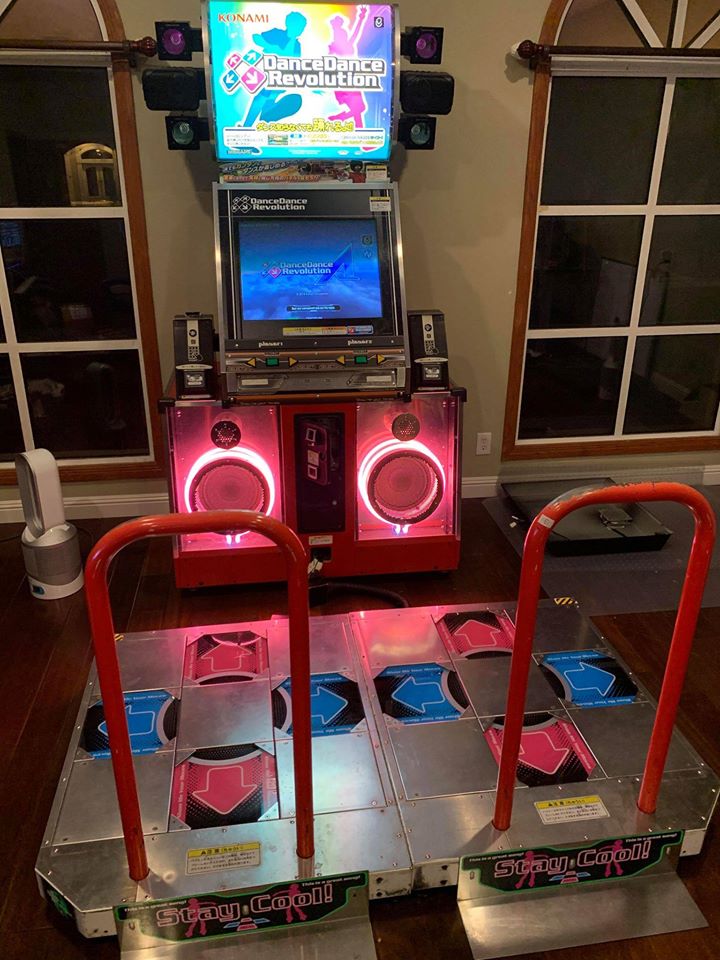
Red cabinets are less common outside of Japan. They generally have red sides and front, as well as two e-amusement card readers and keypads to the sides of the monitor enclosure. They are newer than black cabinets, having begun shipping with SuperNOVA. Their CRTs are superior in that they are flat, more flush, and output 480p instead of 240p/480i.
Solo
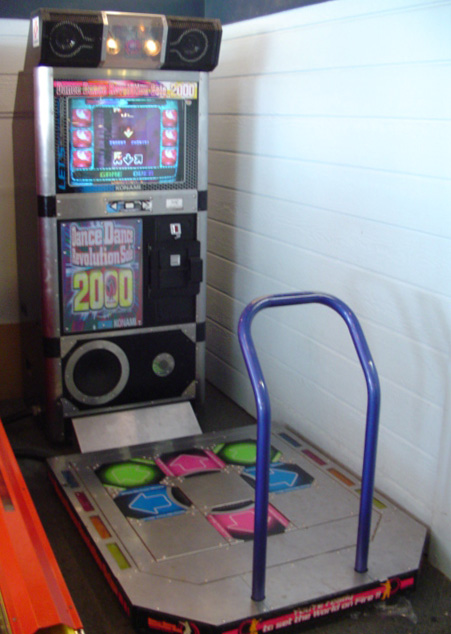
DDR Solo cabinets are single-player, with two additional upper-diagonal arrow panels. Like black cabs, they have 29” CRTs and generally support the same PCBs. Their panels lack lights and have two sensors per panel instead of four. Some Solo stages lack a bar.
Generation 2
Generation 2 cabinets shipped with DDR X through DDR X3 vs 2ndMix. They are often confusingly referred to as “black cabs”, but also “black HD” or “X cabs”. They have 37” 720p LCD screens and marquees that are flush with the rest of the cabinet. They have integrated e-AMUSEMENT Wavepass readers in the bezel of the monitor.
Japanese version
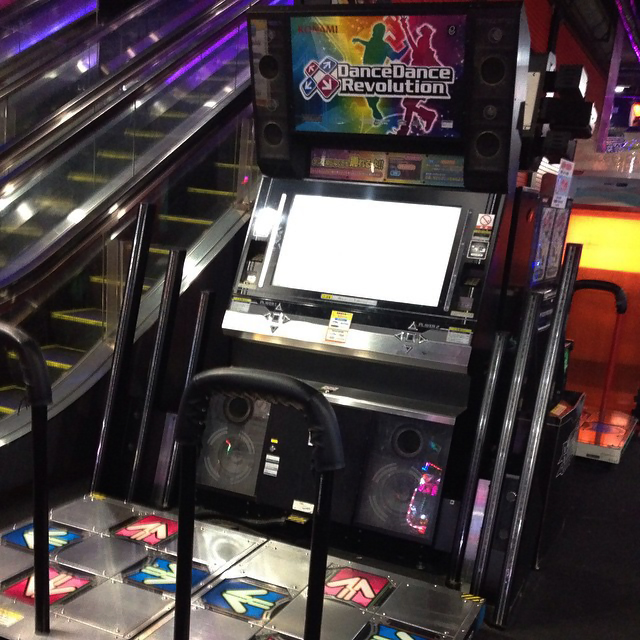
Japanese black HD cabs have light spires on the sides of them. These cabinets also use JAMMA.
American version
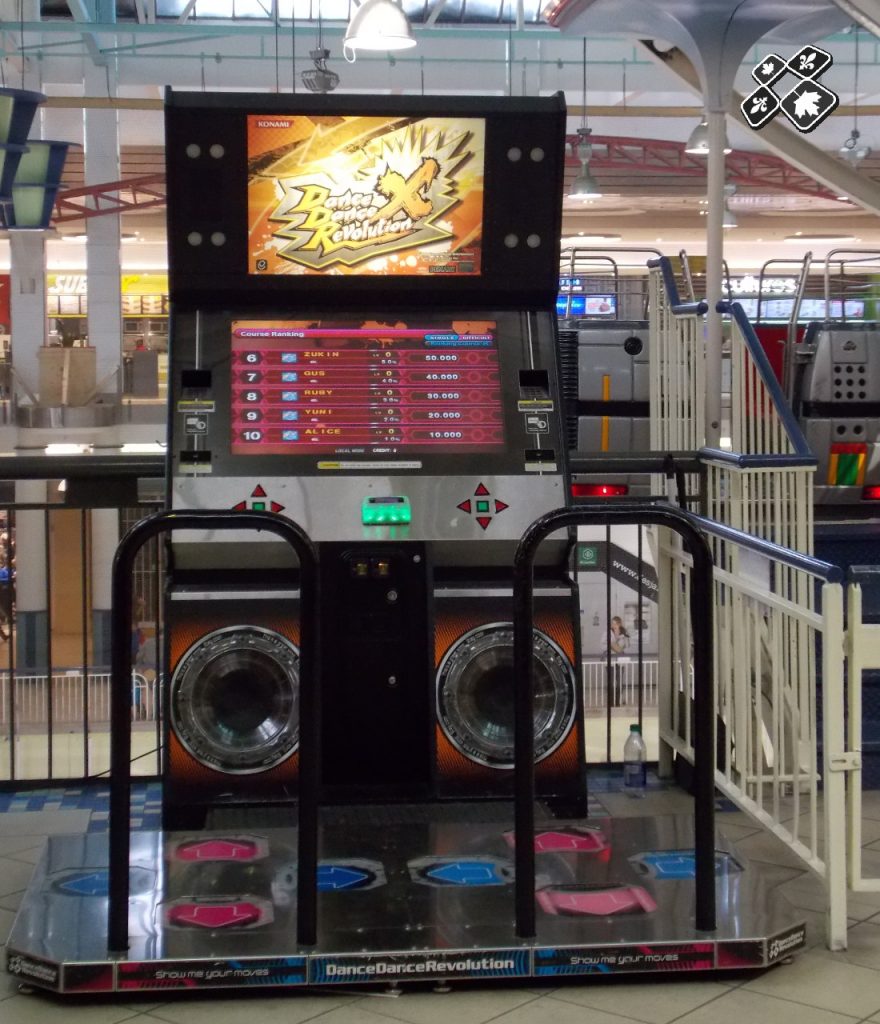
X cabs in America, also referred to as “Raw Thrills” cabinets, lack the light spires that Japanese cabs have. While its screen is of high quality, its pads are shallow and require more maintenance; its I/O is prone to shorting, which causes pad arrows to act as both selection and arrow buttons; and the amp unit has significant latency. Avoid!
X2 version
American X2 cabs have slightly better pads (you can remove a single arrow without taking off the entire stage’s metal cover) and hardware improvements to fix sync issues.
Generation 3
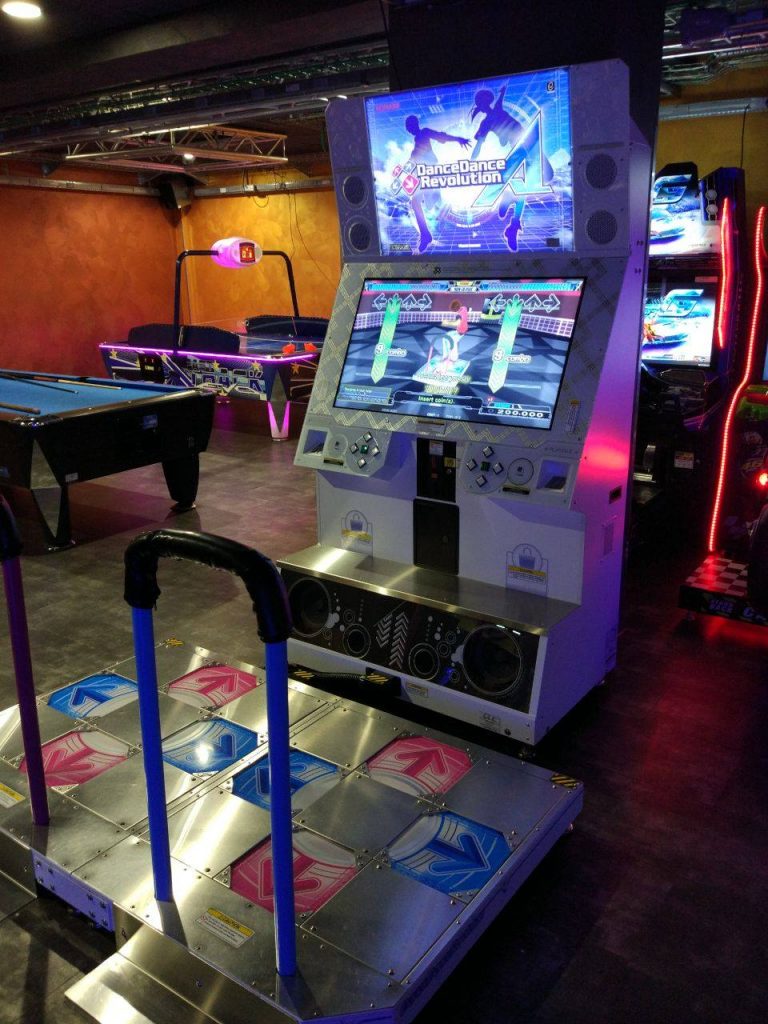
Generation 3 cabinets ship with DDR (2013) through DDR A20 PLUS. They are referred to as white cabinets. They have 42” 1080p LCD screens and smaller subwoofers with a platform to store belongings. They lack lights underneath the arrow panels. You can find them throughout Japanese arcades as well as Dave & Busters and Round1 locations in America. White cabs are manufactured in Japan, Taiwan, or Korea (Uniana). They are generally of the same quality regardless of origin, but certain hardware such as screen manufacturer and sensor connectors might be different. In Japan, they come with generic “Dance Dance Revolution” marquees whereas ones shipped to America have DDR A marquees.
Generation 4
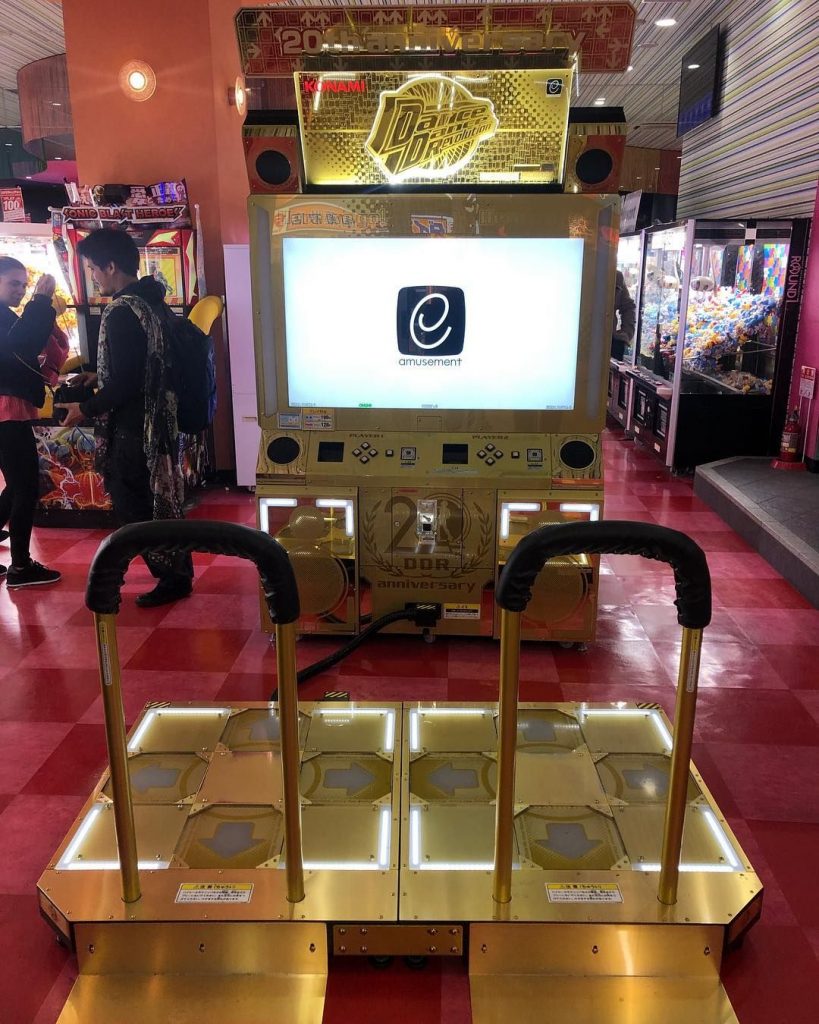
Generation 4 cabinets ship with DDR A20 PLUS. They are called gold cabinets, or officially “20th anniversary model”. They have 55” 1080p LCD screens and look very similar to Dance Rush cabs.
PCBs
The actual computer that contains and runs the game data is on one of many different types of PCBs. These can be found in the back of the machine and are often hooked up to the amp unit, lights, JAMMA harness, monitor, and other parts of the cabinet.
System 573

The System 573 is a PlayStation-based board. Depending on which optical drive is installed, it can play DDR 1st through Extreme.
Python 1

Python 1 is a PlayStation 2-based board. It only has support for Dancing Stage Fusion. This and all newer boards usually require an EXT-IO, a separate board that translates light signals from the PCB into ones that the cab can understand.

Python 2

Python 2 is a box that contains a PlayStation 2. It also contains a USB I/O board commonly referred to as a P2IO. It supports SuperNOVA 1 and 2. Interestingly, by enabling a DIP switch and jumping a few pins, the Python 2 can boot without the need of an EXT-IO, although it will be unable to recognize input from individual sensors.
Bemani PC (Radeon HD 2400)
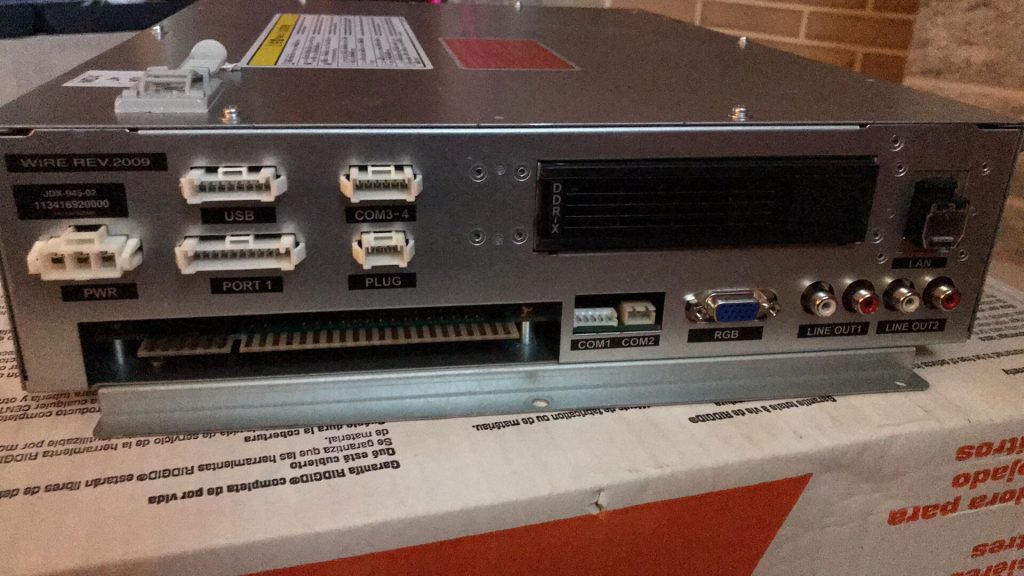
Bemani PC, this version often referred to as “Type 4” or “Dragon”, is a Windows-based PC that can run DDR X through A20 PLUS. It is distinct from other models of Bemani PC by its Radeon HD 2400 GPU. These boxes contain a P3IO board, which translates JAMMA input and other cabinet signals to USB.

Dell Optiplex
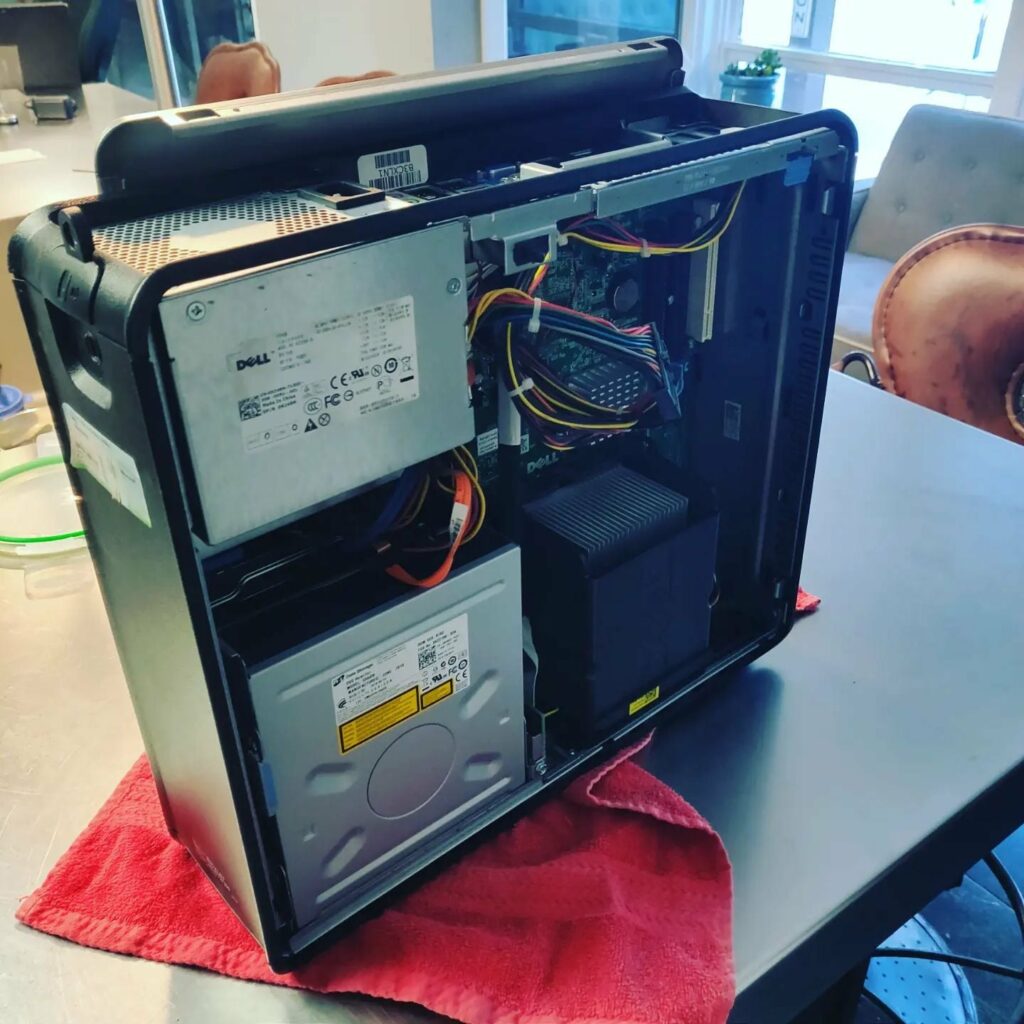
American DDR X/X2 cabs have Dell Optiplex SFF PCs with externally mounted JAMMA I/O, USB, light, audio, and watchdog/fuse boards. The operator’s manual specifies Optiplex 740, but others have found Optiplex 580 in their cabs. Similarly spec’d to the above Bemani PC with an AMD CPU and GPU.
Bemani PC (ADE-704A/HM65)
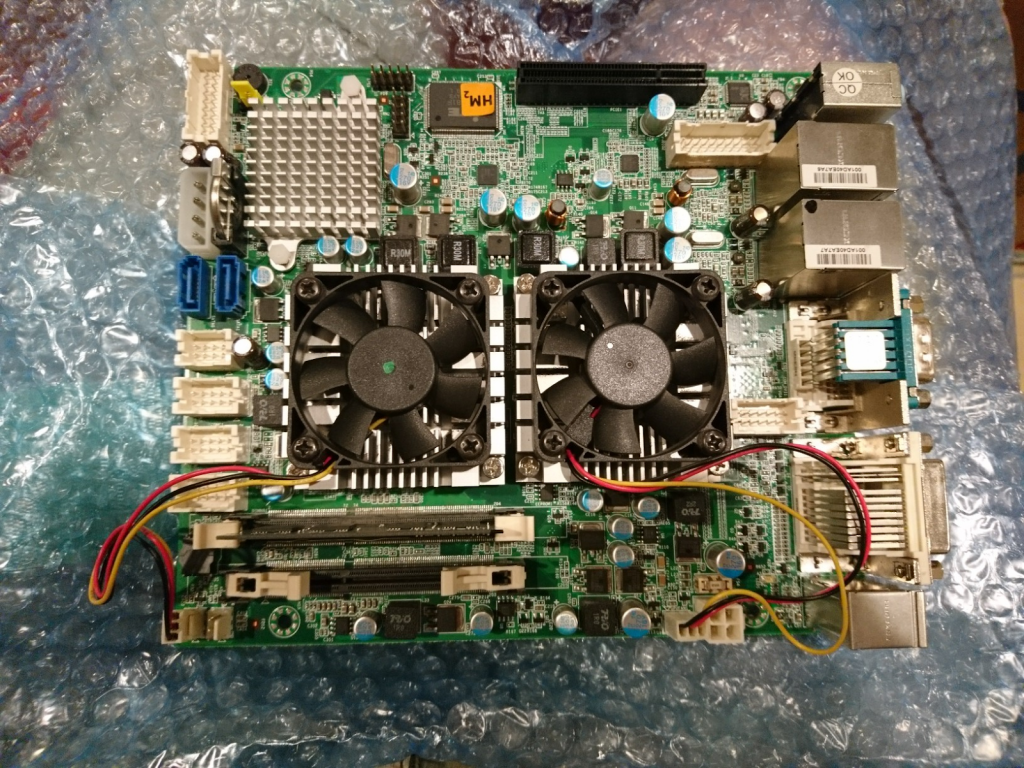
This is another Bemani PC model, sometimes referred to as “Type 5” or “Type 6” depending on where you look, which has a Radeon E4690 GPU. Originally released with DDR A, it also runs A20 PLUS. Contains a P4IO board intended for white cab (non-JAMMA) usage.
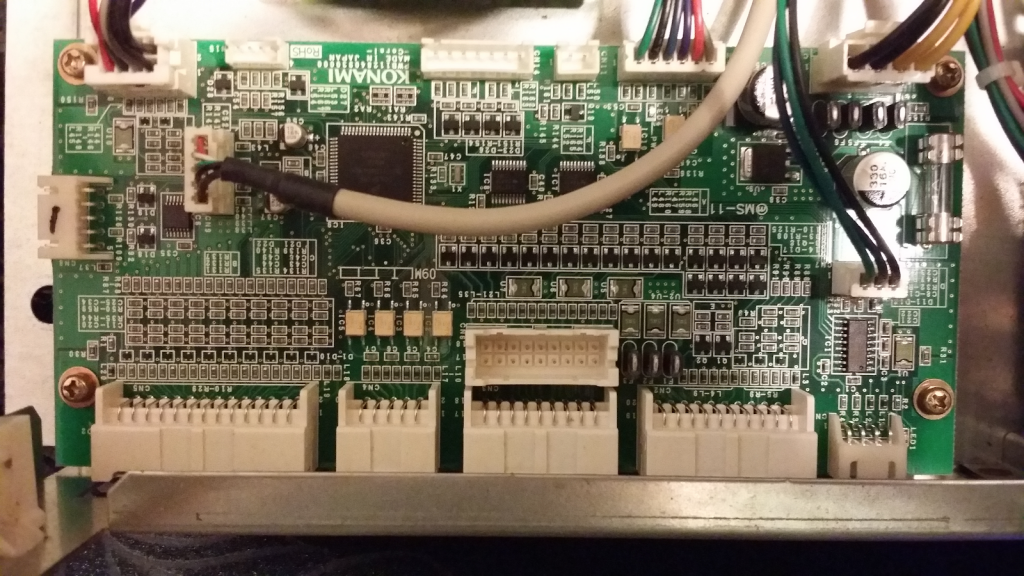
Bemani PC (ADE-6291)

Gold cabinets (and other recent BEMANI games) come with newer Bemani PCs that contain a new I/O board, called a BIO2, which is incompatible with P4IO.
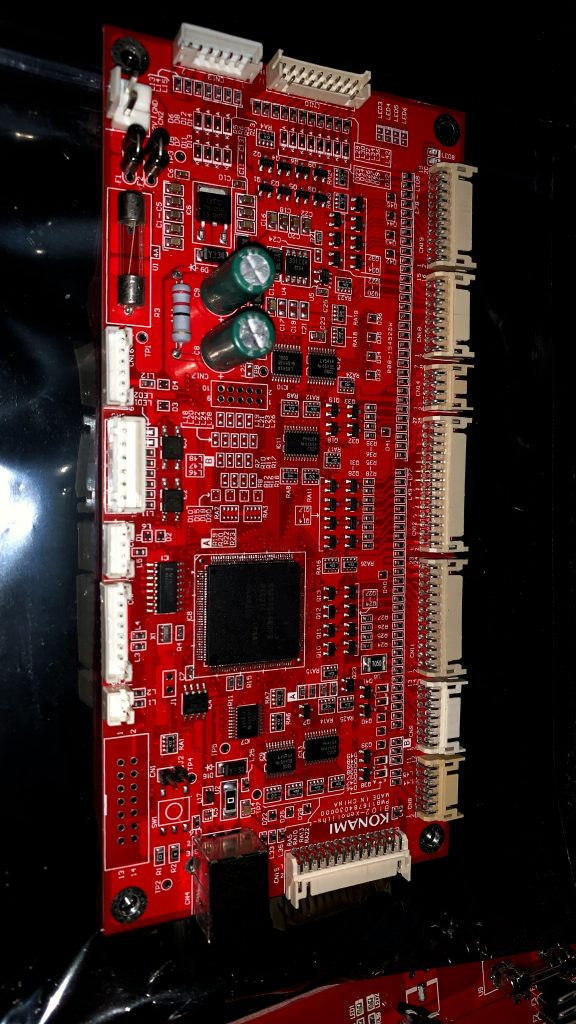
Roxor Boxor

Roxor released several variants of “Boxor” PCs for running In The Groove and In The Groove 2. Kits meant to run in DDR cabinets contain an I/O board called an ITGIO which translates JAMMA signals.
Credits
Thanks to the helpful people on the Buy/Sell/Trade and Private Arcade Owner groups on Facebook.
- Alessandro Tenorio-Bucci
- Ashley Philbrick
- Chris Chike
- Cody Holman
- Dan Colardeau
- Donald Hopkins
- Jesper Petersson
- Joey Platt
- Kevin Jones
- Lob Starmagnet
- Scott Philipp
- Tracy Ward
- Xopher Crossopher Barnett
Other references
- animesuperj, DDR Cabinet Differences
- Chris Langer
- Dance Dance Revolution, GameRepair.info
- Dance Dance Revolution#Hardware, Wikipedia
- In the Groove (series), Wikipedia
- mechacrash
- MonMotha, Difference between Japanese and American DDR Machines
Iam interest
Hi im looking for an cassette for installing the ddr4 th mix
Ive changed the pcmcia in slot2.
any idea where to find one ??
Can it be copied ???
I have a security cassette and original game cd, but impossible to reinstall.
I don’t know. Best to ask this group. https://www.facebook.com/groups/180601838781725/
“similar to Dance Rush cabs”
The DDR gold cabinets ARE Dance Rush cabs. It’s literally the same exact cabinet just painted gold and with DDR pads instead of a Dance Rush pad.
My DDR x2 konami serial number 01230 came stock with a dell optiplex 580. I don’t see this computer mentioned in your story.
That would be the X2 version! I do mention it in this post here: https://jeffreyatw.com/blog/2019/03/types-of-ddr-cabinets-and-pcbs/#x2-version
Edit: ah, sorry, you meant the computer. Yes I didn’t mention that American X2 cabinets have Dell Optiplexes in them. It’s true, they do. Fortunately it looks like you’re getting help from the Private Arcade Owner Facebook group. Best of luck!
Quick correction on the DDR white/gold cabs, they are actually 720p, not 1080p.
…which really sucks on the gold cab because stretching 720p to a 55″ monitor looks awful.
The game runs at 720p but the screens are 1080p.